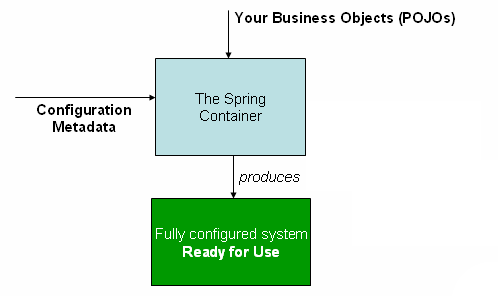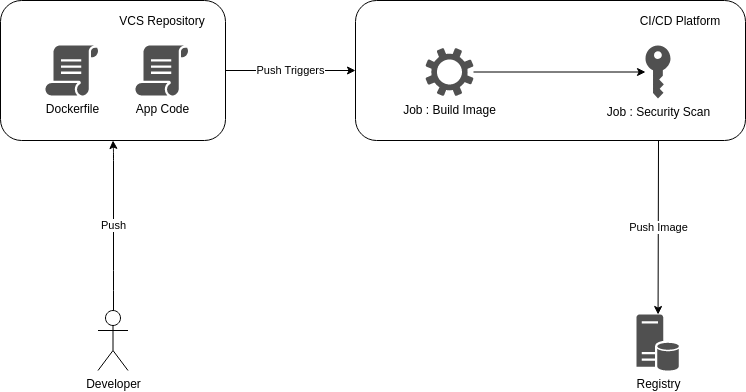本章的内容基于官方文档编写:https://docs.spring.io/spring-framework/docs/current/reference/html/core.html#spring-core
Spring版本为5.2.9
# (一)概述 {#一-概述}
IOC叫做控制反转,从本质上讲,IOC就是把原本由程序员创建的对象的这个动作交给Spring去实现,程序员无需再去管理对象的创建,这种方式可以大大减少系统的偶尔性。
没有IOC之前,对象的创建和对象间的依赖关系都完全编码在程序中,使用IOC之后,对象的创建由程序自己控制,使得程序解耦合。
IOC并不是一种技术,他是一种思想,即控制权反转的思想,DI(依赖注入)则是Spring实现IOC的方法。
Spring容器在初始化时根据配置文件或元数据创建和组织对象存入容器中,需要使用时再从IOC容器中获取。

# (二)创建第一个Spring程序 {#二-创建第一个spring程序}
1、首先确保你已经创建完成Maven项目并引入了Spring依赖,这里只需要引入spring-webmvc即可
<!-- https://mvnrepository.com/artifact/org.springframework/spring-webmvc -->
<dependency>
<groupId>org.springframework</groupId>
<artifactId>spring-webmvc</artifactId>
<version>5.2.9.RELEASE</version>
</dependency>
2、创建实体类
public class User {
private int id;
private String name;
//省略构造方法、get、set、toString方法
}
3、基于 XML 配置容器
<?xml version="1.0" encoding="UTF-8"?>
<beans xmlns="http://www.springframework.org/schema/beans"
xmlns:xsi="http://www.w3.org/2001/XMLSchema-instance"
xsi:schemaLocation="http://www.springframework.org/schema/beans
https://www.springframework.org/schema/beans/spring-beans.xsd">
<!--使用spring创建对象-->
<bean id="user" class="com.javayz.pojo.User">
<property name="id" value="1"/>
<property name="name" value="javayz"/>
</bean>
</beans>
其中id用来标识这个bean,class指向该类的全限定名
4、实例化容器
@Test
public void test(){
//获取Spring的上下文对象
ApplicationContext context = new ClassPathXmlApplicationContext("bean.xml");
//获取bean
User user = (User) context.getBean("user");
System.out.println(user.toString());
}
只需要上面的四步,我们就实现了通过Spring创建对象。这个过程就是控制反转,由Spring的IOC容器来控制对象的创建权。
# (三)IOC创建对象的方式 {#三-ioc创建对象的方式}
# 3.1、默认使用无参构造方法创建对象 {#_3-1、默认使用无参构造方法创建对象}
这一点很好验证,如果我们把User对象的无参构造方法给去掉,你可以看到这样的报错信息:

当然也可以使用有参构造方法,我们需要用到另外一个参数constructor-arg
<!--使用spring创建对象-->
<bean id="user" class="com.javayz.pojo.User">
<constructor-arg index="0" value="1"/>
<constructor-arg index="1" value="javayz"/>
</bean>
上面是通过下标的实现方式,再来看一下通过变量名的方式
<bean id="user" class="com.javayz.pojo.User">
<constructor-arg name="id" value="1"/>
<constructor-arg name="name" value="javayz"/>
</bean>
构造器注入是Spring依赖注入的一种方式,接下来我会把其他的几种注入方式都介绍一遍。
# (四) Spring的配置 {#四-spring的配置}
Spring的配置文件没有太多参数,这里就来总结一下
# 4.1 alias标签 {#_4-1-alias标签}
别名就是你可以给bean的id换一个其他的名字
<bean id="user" class="com.javayz.pojo.User">
<constructor-arg name="id" value="1"/>
<constructor-arg name="name" value="javayz"/>
</bean>
<alias name="user" alias="user2"/>
现在使用user和user2都可以访问到这个bean
# 4.2 bean标签 {#_4-2-bean标签}
bean标签是通过xml配置中最常用的,主要会用的几个参数
id :bean的唯一标识
class :bean对象所对应的全限定名
name : 别名,可以取多个名字
scope : 作用域,Spring默认作用域是singleton
<bean id="user" class="com.javayz.pojo.User" name="user3" scope="singleton">
<constructor-arg name="id" value="1"/>
<constructor-arg name="name" value="javayz"/>
</bean>
# 4.3 import {#_4-3-import}
import标签可以把多个xml配置文件导入到一个总的配置文件中供程序员调用。
<import resource="bean.xml"/>
# 4.4 cp命名空间 {#_4-4-cp命名空间}
c命名空间和p命名空间可以简化xml文件
使用时首先需要引入xmlns
xmlns:p="http://www.springframework.org/schema/p"
xmlns:c="http://www.springframework.org/schema/c"
c命名空间可以直接在bean标签下注入构造器

p命名空间可以直接注入属性的值

# (五)依赖注入的两种方式 {#五-依赖注入的两种方式}
# 5.1 构造器注入 {#_5-1-构造器注入}
构造器注入就是前面所讲的方式,通过无参或者有参的构造方法注入对象。
# 5.2 Set方法注入 {#_5-2-set方法注入}
Set方法可以注入更加复杂的对象

官网说Set方法支持上面这九种方式的注入,我们来模拟一下 我们新建一个User类包含上面的所有复杂类型:
public class User {
private String name;
private Father father;
private String[] arrays;
private List<String> list;
private Map<String,String> map;
private Set<String> set;
private Properties prop;
private String isNUll;
//不需要构造方法 , 省略get、set、toString
}
然后在bean的xml中来注入所有值
<?xml version="1.0" encoding="UTF-8"?>
<beans xmlns="http://www.springframework.org/schema/beans"
xmlns:xsi="http://www.w3.org/2001/XMLSchema-instance"
xsi:schemaLocation="http://www.springframework.org/schema/beans
https://www.springframework.org/schema/beans/spring-beans.xsd">
<bean id="father" class="com.javayz.pojo.Father"/>
<bean id="user" class="com.javayz.pojo.User">
<!--基础类型用value注入-->
<property name="name" value="javayz"/>
<!--bean注入,使用ref -->
<property name="father" ref="father"/>
<!--数组注入,使用array -->
<property name="arrays">
<array>
<value>array1</value>
<value>array2</value>
</array>
</property>
<!--list注入,使用list -->
<property name="list">
<list>
<value>list1</value>
<value>list2</value>
</list>
</property>
<!--map注入,使用map -->
<property name="map">
<map>
<entry key="1" value="a"/>
<entry key="2" value="b"/>
</map>
</property>
<!--set注入,使用set -->
<property name="set">
<set>
<value>set1</value>
<value>set2</value>
</set>
</property>
<!--Prop注入,使用prop -->
<property name="prop">
<props>
<prop key="key1">value1</prop>
<prop key="key2">value2</prop>
</props>
</property>
<!--NUll注入,使用null -->
<property name="isNUll">
<null/>
</property>
</bean>
</beans>
# (六)总结 {#六-总结}
上面展示的所有内容其实都可以在官方文档中找到,只不过官方文档内容会更加繁琐,并且没有官方的中文版本,所以我的建议是官方文档是第一手资料,但是你也可以看我的系列博客,我会尽可能的将官方文档的内容变得通俗易懂。
 51工具盒子
51工具盒子




